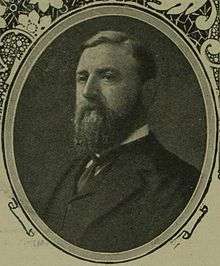Forfar (UK Parliament constituency)
Forfarshire was a county constituency represented in the House of Commons of Great Britain of the Parliament of the United Kingdom from 1708 until 1800, and then in the House of Commons of the United Kingdom until 1950.
It elected one Member of Parliament (MP) using the first-past-the-post voting system.
Boundaries
The Representation of the People Act 1918 defined the constituency as consisting of the county of Forfar, except the county of the city of Dundee and the burghs of Montrose, Arbroath, Brechin, and Forfar. The four excepted burghs formed part of the Montrose District of Burghs.[1]
The county of Forfarshire was renamed Angus in 1928.[2] However, no change was made in the name of the constituency prior to its abolition.
Redistribution
The constituency was abolished under the Representation of the People Act 1948, which reorganised parliamentary boundaries throughout the United Kingdom. The seat was divided between North Angus and Mearns (which also included Kincardineshire) and South Angus.[3] The new constituencies were first contested in the 1950 general election.
Members of Parliament
Election results
Elections in the 1880s
At the 1880 General Election, James William Barclay was elected unopposed.[5]
Elections in the 1890s

John Sinclair
Elections in the 1900s

James Falconer
Elections in the 1910s
Elections in the 1920s
Elections in the 1930s
Elections in the 1940s
General Election 1939/40:
Another General Election was required to take place before the end of 1940. The political parties had been making preparations for an election to take place from 1939 and by the end of this year, the following candidates had been selected;
References
- ↑ Representation of the People Act 1918, Ninth Schedule, Part II, Parliamentary Counties in Scotland
- ↑ "Angus - What's in a name". Angus Council. Retrieved 2008-03-19.
- ↑ Representation of the People Act 1948, First Schedule, Parliamentary Constituencies, Part III: Scotland
- ↑ Leigh Rayment's Historical List of MPs – Constituencies beginning with "F"
- ↑ The Times, April 1880.
- 1 2 Debrett's House of Commons and the Judicial Bench, 1889
- ↑ Whitaker's Almanack, 1893
- ↑ "Election Intelligence: Forfarshire". The Times. 20 November 1894. p. 6.
- 1 2 3 Debrett's House of Commons and the Judicial Bench
- ↑ Whitaker's Almanack, 1907
- ↑ The Times, 2 March 1909 p8
- 1 2 Debrett's House of Commons and the Judicial Bench illustrated with 500 armorial engravings (PDF). London: Dean & Son. 1918. p. 221. Retrieved 12 May 2009.
- ↑ Whitaker's Almanack, 1920
- ↑ The Times, 17 November 1922
- ↑ The Times, 8 December 1923
- ↑ Oliver & Boyd's Edinburgh Almanac, 1927
- ↑ The Times, 1 June 1929
- ↑ Whitaker's Almanack, 1934
- ↑ Whitaker's Almanack, 1939
|
|---|
|
|
|
|
|
- Aberdeen North
- Aberdeen South
- Airdrie & Shotts
- Angus
- Argyll & Bute
- Ayr, Carrick & Cumnock
- Banff & Buchan
- Berwickshire, Roxburgh & Selkirk
- Caithness, Sutherland & Easter Ross
- Central Ayrshire
- Coatbridge, Chryston & Bellshill
- Cumbernauld, Kilsyth & Kirkintilloch East
- Dumfries & Galloway
- Dumfriesshire, Clydesdale & Tweeddale
- Dundee East
- Dundee West
- Dunfermline & West Fife
- East Dunbartonshire
- East Kilbride, Strathaven & Lesmahagow
- East Lothian
- East Renfrewshire
- Edinburgh East
- Edinburgh North & Leith
- Edinburgh South
- Edinburgh South West
- Edinburgh West
- Falkirk
- Glasgow Central
- Glasgow East
- Glasgow North
- Glasgow North East
- Glasgow North West
- Glasgow South
- Glasgow South West
- Glenrothes
- Gordon
- Inverclyde
- Inverness, Nairn, Badenoch & Strathspey
- Kilmarnock & Loudoun
- Kirkcaldy & Cowdenbeath
- Lanark & Hamilton East
- Linlithgow & East Falkirk
- Livingston
- Midlothian
- Moray
- Motherwell & Wishaw
- Na h-Eileanan an Iar
- North Ayrshire & Arran
- North East Fife
- Ochil & South Perthshire
- Orkney & Shetland
- Paisley & Renfrewshire North
- Paisley & Renfrewshire South
- Perth & North Perthshire
- Ross, Skye & Lochaber
- Rutherglen & Hamilton West
- Stirling
- West Aberdeenshire & Kincardine
- West Dunbartonshire
|

